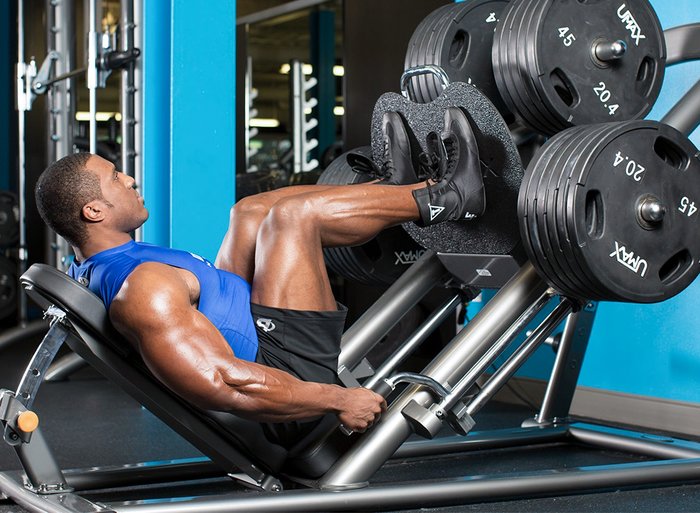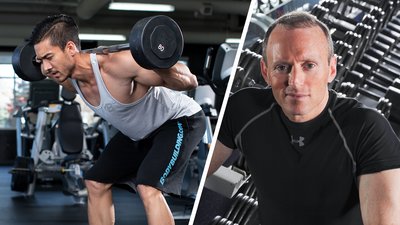Q: Everyone says that squats are the best exercise for total leg development, but I'm not feeling it in my hamstrings. Are squats really all I need to build my hamstrings?
It's a claim that never seems to die. It's published in magazine and internet articles, bandied about in fitness forums and social media outlets and perpetuated by high-profile fitness pros. "Just do compound lower-body movements, and your hamstrings will get all the work they need to grow." Many simply take it as gospel, but this advice actually has little basis in science.
The idea that the hamstrings are maximally stimulated during a compound movement doesn't make sense anatomically. The hamstring muscles are biarticular, meaning that they cross two joints—the knee and hip joints. (Nerd note: The exception is the short head of the biceps femoris, which crosses the knee and technically is not a true hamstring.) At the knee, the hamstrings act as a flexor; at the hip they act as an extensor.
What happens when you descend into a squat? Try it. The hamstrings shorten at the knee and lengthen at the hip. The opposite occurs on the concentric portion of the lift, when you come back up—the hamstrings lengthen at the knee and shorten at the hip. The length of the muscle complex doesn't really change all that much throughout the movement, a phenomenon that is not ideal for maximizing muscle stimulation.

Research supports the fact that hamstring activity is low during compound lower-body exercises. In a study from my lab involving the leg press, the biceps femoris was significantly less active than the quadriceps muscles during the exercise—roughly 25 percent as active as the vasti muscles and just a third as active as the rectus femoris.[1] Safe to say that the hammies don't get much work when you do leg presses—and if you think that squatting shows substantially greater hamstring activation, think again.
A 2009 study showed only 27 percent of maximal voluntary isometric contraction of the hamstrings during the squat, which led the author to conclude that the squat "is not an optimal exercise for training the hamstrings."[2]
Maybe you don't put much stock in muscle activation and want to argue that long-term studies that directly measure hypertrophy are all that matters. Fair enough. A study published in the Journal of Orthopaedic and Sports Physical Therapy provides direct evidence that squats don't do much for hamstring growth.[3] The subjects performed 4 sets of squats to approximately parallel depth using either a low, medium, or high rep range, training three days a week for seven weeks. The results showed significant increases in hypertrophy of the quads in all the subjects using all the rep ranges, while the hamstrings in all of the groups had no changes from baseline.
So, how do you get your hammies to grow? The answer is simple: Do single-joint exercises that directly target them. Good choices include exercises originating at the hip joint, like stiff-legged deadlifts and good mornings, as well as exercises originating at the knee, like leg curls. Ideally, you want to combine both types of movements to optimize hamstring growth.
A key point about these single-joint exercises is that when one joint is working, the other is fixed, creating a favorable length-tension relationship in which the hamstrings are stretched and shortened throughout the range of motion.
If the hamstrings are a weak point for you, prioritize them by training them first in your leg workout. That way you can channel all your efforts into them when you're fresh, bringing greater gains over the long haul.
Do you like legs workouts that are created by experts but still up to the standards of gym rats? Then try the Built by Science 6-Week Muscle-Building Plan, only on Bodybuilding.com BodyFit Elite! You'll get a solid education in kinesiology and exercise science, while also making solid gains in the weight room!
References
- Schoenfeld, B.J.; Contreras, B.; Willardson, J.M.; Fontana, F.; and Tiryaki-Sonmez, G. (2014). Muscle activation during low- versus high-load resistance training in well-trained men. European Journal of Applied Physiology, 114(12), 2491-2497.
- Ebben, W.P. (2009). Hamstring activation during lower body resistance training exercises. International Journal of Sports Physiology Performance, 4(1), 84-96.
- Weiss, L.W.; Coney, H.D.; and Clark, F.C. (2000). Gross measures of exercise-induced muscular hypertrophy. Journal of Orthopaedic and Sports Physical Therapy, 30(3), 143-148.

